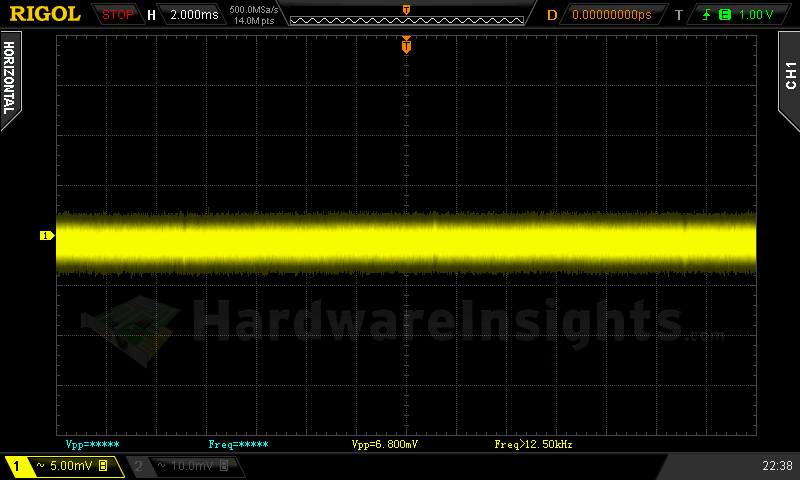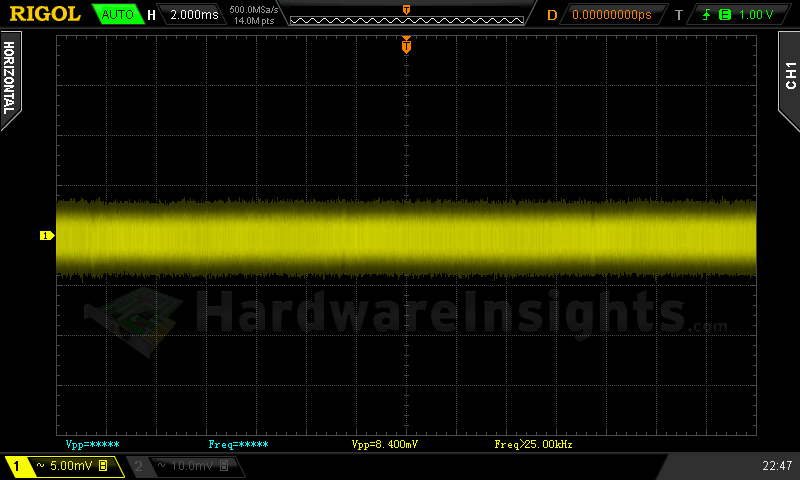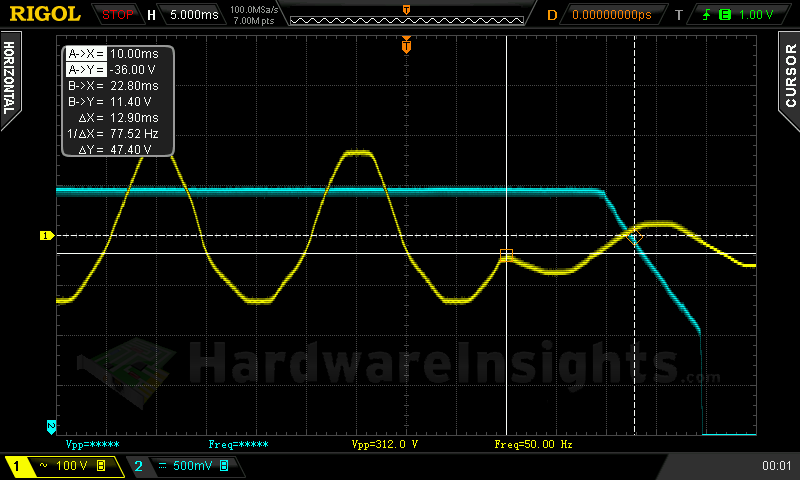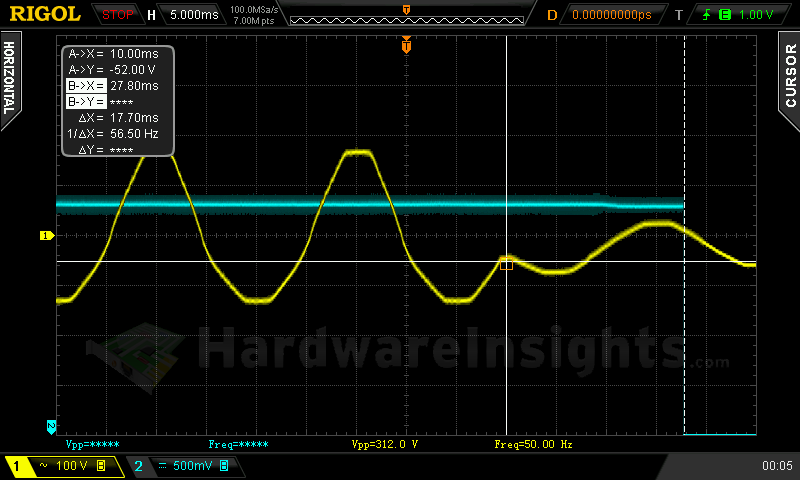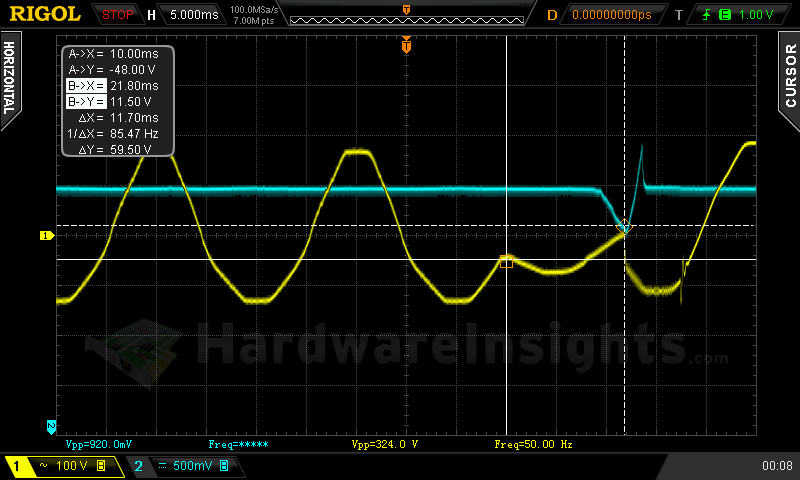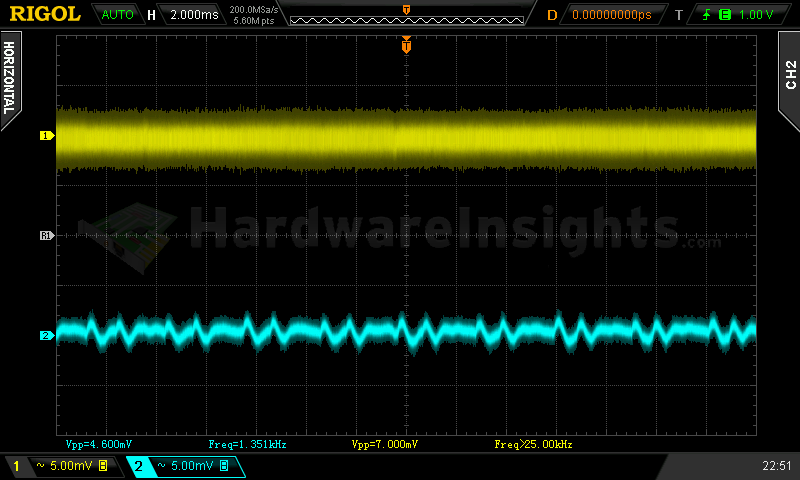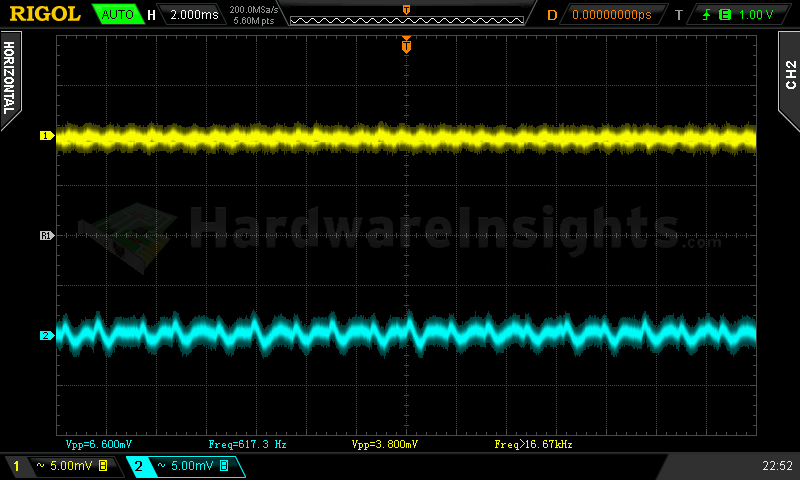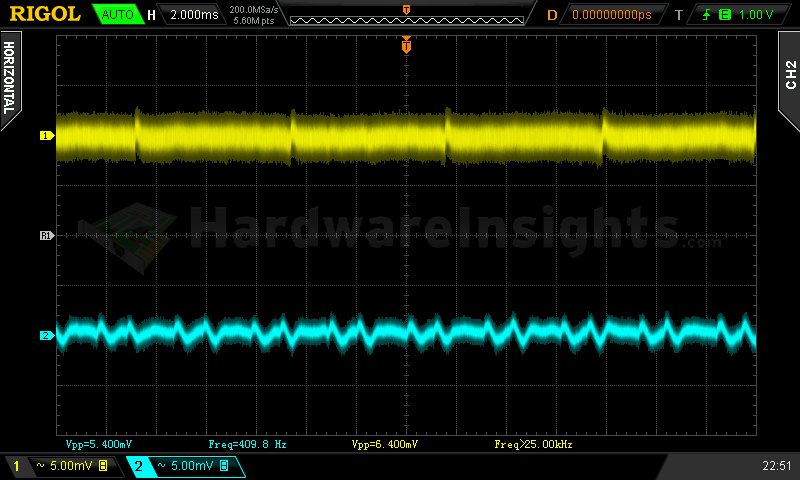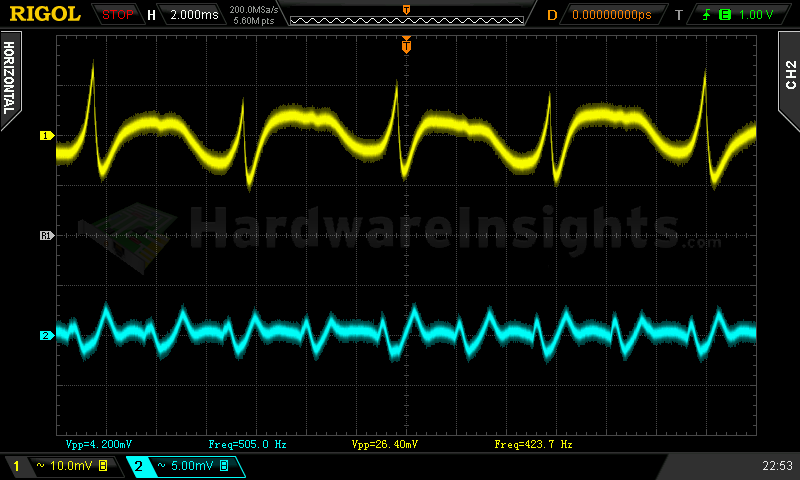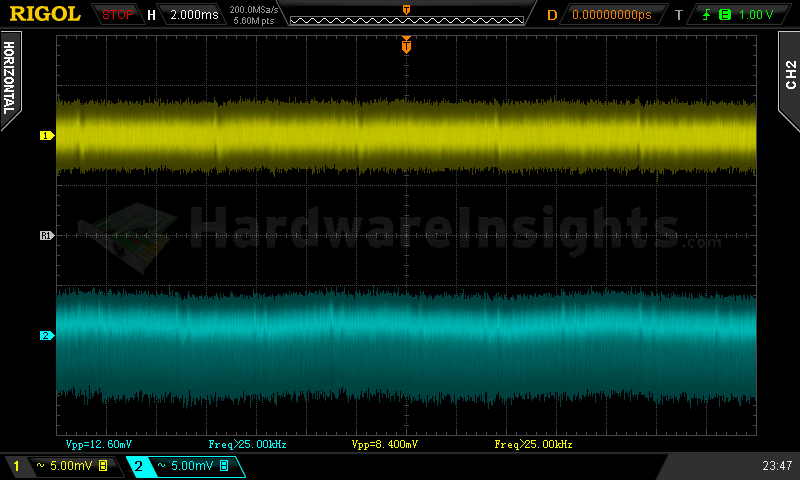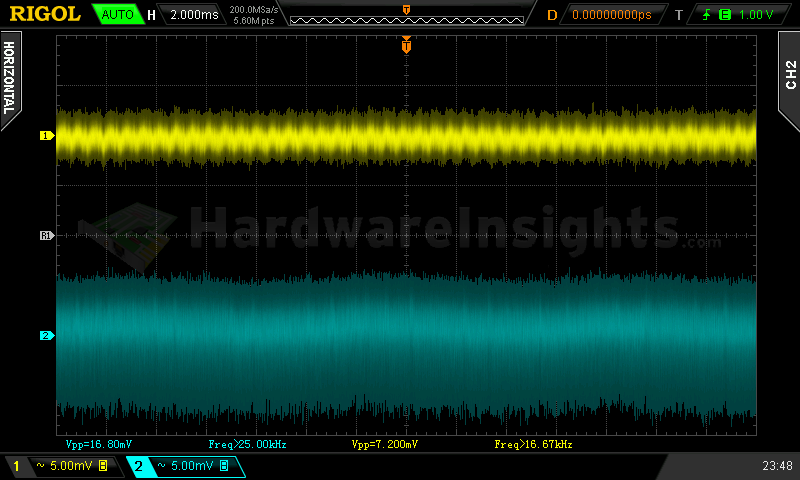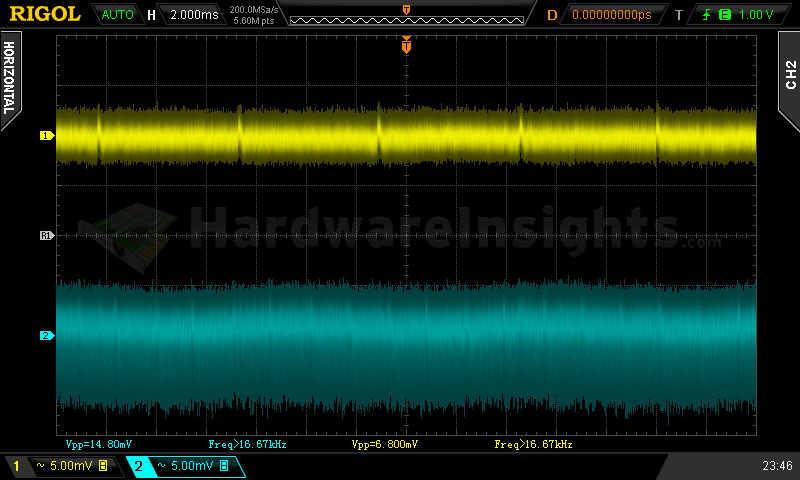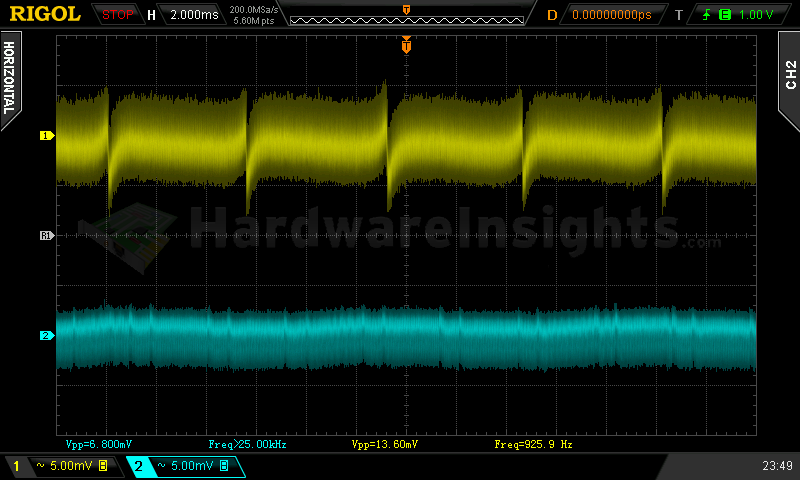Contents
- 1Introducing the Silverstone Strider Titanium 600 W (SST-ST60F-TI)
- 1.1Packaging and accessories
- 2Connectors & cabling
- 2.1Casing & cooling
- 3Input filtering
- 4Primary side
- 4.1+5 V stand-by rail
- 5Secondary side
- 5.1Build quality
- 6Load testing
- 6.1Loading +5 V SB
- 6.2Hold-up time
- 6.3Combined loading
- 6.4Combined loading ripple
- 6.5Crossloading, overloading
- 6.6Crossloading, overloading ripple
- 6.7Fan speed, temperatures and noise
- 7Conclusion and evaluation
- 7.1Thanks
- 7.2Discussion
Load testing
Loading +5 V SB
As always, all load testing is done according to our testing methodology. The voltage regulation is definitely bad for such a high-end unit. Basically, the same situation happened here as it did with the Cooler Master V550S. Hello, Enhance, the nominal voltage is 5 V! Not 4.91 V! Maybe setting the no-load output to 5.05 would mean going down to only 4.95 which would then be a nice 1% regulation. Now this is not even 3% regulation. At least the ripple suppression is good, and efficiency is quite above average with the maximum hitting close to 80 %.
| Output (W) | Load (A) | Voltage (V)/ ripple (mV) | Input (W) | Efficiency/power factor |
| 0 | 0 | 4.94/6.800 | 0 | —/0.000 |
| 11.54 | 2.37 | 4.87/8.400 | 14.54 | 79.4 %/0.258 |
| 16.07 | 3.32 | 4.84/8.400 | 20.67 | 77.7 %/0.332 |
+5 V SB ripple (left to right): 0 A; 2.37 A; 3.32 A
Hold-up time
As we can see on the oscilloscope screenshot, the hold-up time of the SST-ST60F-TI +12 V rail is quite short, just 12.90 ms.
The hold-up time of the power good signal is much longer though, 17.70 ms. Adopting Sirtec’s habits, aren’t we Enhance? This violates the ATX spec, which dictates the PG signal must drop first, and only after may the voltage drop out of spec. I think I will deduct a point for this.
The unit will lose many points anyway as the voltage HUT is quite short, well below ATX spec and not to mention my own high-end requirements. When checking what happens with a precise interruption for a given time, I found that there were some further voltage drops, so that the maximum time for the unit to stay in spec with the +12 V rail was 11.70 ms. Barely above my absolute minimum of 10 ms.
Combined loading
Combined loading was not that great for the Silverstone SST-ST60F-TI. Firstly, let’s talk about the voltage regulation. As this is a synchronously-rectified topology with DC–DC converters, the results are expected to be good. But it was not that great. The voltage on the +12 V rail is set quite low from the factory at 11.83 V. In this regard the unit showed great load regulation as the voltage stayed the same basically the whole time. This is the best load regulation I have ever seen so I think it is fair to grant two points for this. In such a situation, it just makes me wonder why the hell they did not set the voltage to 12.00 V?! We have a saying here which would be translated as “they don’t see the forest for the trees” and which I think exactly describes this situation. Enhance focused solely on load regulation and somehow forgot that the nominal voltage is 12.00 V, not 11.83 V. Again! They did the same with the stand-by rail! And in both cases the voltage is lower which also decreases efficiency and increases currents.
| Output power | Load/ voltage +5 V SB | Load/ voltage +3.3 V | Load/ voltage +5 V | Load/ voltage +12 V | Load/ voltage −12 V | Input power | Efficiency/ power factor |
| 4.2 %/ 25.18 W | 0 A/ 5.03 V | 0 A/ 3.36 V | 0.275/ 5.02 V | 1.769 A/ 11.82 V | 0.272 A/ −10.62 V | 33.55 W | 75.1 %/ 0.505 |
| 10 %/ 60.50 W | 0.531 A/ 5.02 V | 3.09 A/ 3.35 V | 1.433 A/ 5.01 V | 3.17 A/ 11.83 V | 0.265 A/ −10.57 V | 68.31 W | 88.6 %/ 0.714 |
| 20 %/ 118.16 W | 0.532 A/ 5.01 V | 4.06 A/ 3.34 V | 3.27 A/ 5.01 V | 6.99 A/ 11.83 V | 0.266 A/ −10.75 V | 129.8 W | 91.0 %/ 0.848 |
| 40 %/ 241.50 W | 1.01 A/ 5.00 V | 4.04 A/ 3.33 V | 4.61 A/ 5.00 V | 16.63 A/ 11.83 V | 0.288 A/ −11.13 V | 262.4 W | 92.0 %/ 0.928 |
| 60 %/ 358.33 W | 1.52 A/ 4.98 V | 5.46 A/ 3.32 V | 5.77 A/ 4.99 V | 25.4 A/ 11.83 V | 0.289 A/ −11.58 V | 393.1 W | 91.2 %/ 0.953 |
|
80 %/ 486.21 |
1.88 A/ 4.97 V | 6.91 A/ 3.31 V | 7.58 A/ 4.97 V | 34.9 A/ 11.83 V | 0.291 A/ −11.90 V | 539.6 W | 90.1 %/ 0.970 |
| 100 %/ 601.66 W | 2.37 A/ 4.95 V | 8.27 A/ 3.30 V | 8.99 A/ 4.97 V | 43.5 A/ 11.83 V | 0.283 A/ −11.91 V | 678.1 W | 88.7 %/ 0.972 |
As a result of the low +12 V rail voltage, this also caused the −12 V rail to start high. Damn too high… It does not even meet ATX specification!! Only the fact that I am a somewhat realistic person, and am aware that this rail has basically no use in the real world anymore saves this unit from getting the FAILED result. Though missing the regulation spec three times so far for a unit that is supposed to be in the high-end segment is unprecedented, and such thing can simply not happen for a unit of this price! The ATX norm still stands, so I feel right to at least “award” the unit with minus three points per failed measurement. That would be −9 points here. I hope manufacturers will get the message.
As for the efficiency, at 10% load the efficiency does not meet 90 % yet, but with my current instrument configuration I am constantly getting about 2 % overall lower figures in general, which is consistent. It is still a very good result though. The maximum we reached was 92 %, and the maximum Ecova (where the unit had to be officially tested) measured was about two and half percent higher (but at 50% load). Though at maximum load my results are much lower than the usual discrepancy, and other reviews which have come out so far are confirm my result. I think Enhance reaches the Titanium certification here but so far it seems as though they’re playing the card, so-to-speak, as it is only passing just barely, especially at 100% output. I don’t think we’ll see anything lower than 600W 80 PLUS Titanium certified units from Enhance for some time.
Combined loading ripple
The ripple values of the SST-ST60F-TI are very nice. Besides the −12 V rail everything was within 20 mV. It took this rail a little time to reach a high-enough voltage for the regulator to even start working, and after that the ripple even further decreased. It is also worth noting that other rails even stayed under 10 mV in 24 out of 28 cases. That is over 85 % so I award two extra points.
| Output % | Ripple +5 V SB | Ripple +3.3 V | Ripple +5 V | Ripple +12 V | Ripple −12 V |
| 4.2 | 7.000 mV | 3.800 mV | 6.400 mV | 6.600 mV | 26.40 mV |
| 10 | 3.400 mV | 2.600 mV | 4.200 mV | 8.800 mV | 26.00 mV |
| 20 | 4.200 mV | 5.400 mV | 4.800 mV | 5.800 mV | 26.80 mV |
| 40 | 8.800 mV | 4.200 mV | 8.000 mV | 12.00 mV | 27.60 mV |
| 60 | 9.80 mV | 5.600 mV | 8.800 mV | 10.60 mV | 30.40 mV |
| 80 | 6.200 mV | 5.400 mV | 6.600 mV | 16.00 mV | 18.40 mV |
| 100 | 8.400 mV | 7.200 mV | 6.800 mV | 16.80 mV | 13.60 mV |
Ripple 4.2% load (left to right): +5 V SB; +3.3 V; +5 V; −12 V. The second channel is connected to +12 V.
Ripple 100% load (left to right): +5 V SB; +3.3 V; +5 V; −12 V. The second channel is connected to +12 V.
Crossloading, overloading
Crossloading tests went fine, as is expected from a platform utilizing DC–DC converters. Well, besides the −12 V rail which once again dipped under the minimum ATX spec (that’s minus 3 points) with the unit operating at a low power output. Otherwise the regulation was mostly the same. Efficiency was mostly between 85 and 90 % here. That is a good result, and compared to similarly performing units I think it is fair to give an extra point for that. As for protections, OTP works and the unit turned off after eight and half minutes with its fan simulated being stuck. I haven’t reached limits on either the +3.3 or +5 V rails, but on the +12 V rail the OCP limit is slightly above 51 A. That is actually very little over the rail’s maximum.
| Output power | Load/ voltage +5 V SB | Load/ voltage +3.3 V | Load/ voltage +5 V | Load/ voltage +12 V | Load/ voltage −12 V | Input power | Efficiency/ power factor |
| 16 %/ 94.01 W | 0.524 A/ 4.97 V | 19.77 A/ 3.33 V | 0.265 A/ 5.00 V | 1.807 A/ 11.83 V | 0.267 A/ −10.74 V | 111.2 W | 84.5 %/ 0.826 |
| 21 %/ 124.71 W | 0.535 A/ 5.13 V | 0 A/ 3.34 | 19.5 A/ 5.01 V | 1.800 A/ 11.83 V | 0.266 A/ −10.80 V | 145.0 W | 86.0 %/ 0.864 |
| 100 %/ 597.81 W | 0.523 A/ 4.95 V | 0 A/ 3.32 V | 0.298 A/ 4.98 V | 49.9 A/ 11.83 V | 0.287 A/ −11.90 V | 665.2 W | 89.8 %/ 0.971 |
| 139 %/ 834.31 W | 3.30 A/ 4.91 V | 22.4 A/ 3.26 V | 28.3 A/ 4.95 V | 50.8 A/ 11.84 V | 0.296 A/ −11.94 V | 986.2 W | 84.6 %/ 0.979 |
The combined limit for OPP however is much higher. I have only been able to push the +3.3 and +5 V rails so far which resulted in almost 40 % over the nominal power output. And all the outputs were still well within ATX specification. I think the unit will be able to provide close to 900 W with everything maxed out. So while I did not reach the point when the OPP kicked in, I think with the unit still functioning well with a 40% overload, there’s no doubt that the unit will provide stable power before it does actually shut itself off. This is nice, even though the efficiency dropped down further to about 85%, and for this result the unit gets an extra point as well.
Crossloading, overloading ripple
The ripple is still outstanding, there is nothing more to add.
| Output % | Ripple +5 V SB | Ripple +3.3 V | Ripple +5 V | Ripple +12 V | Ripple −12 V |
| 16 | 7.800 mV | 3.400 mV | 7.600 mV | 10.40 mV | 23.20 mV |
| 21 | 8.000 mV | 4.600 mV | 7.800 mV | 11.00 mV | 23.20 mV |
| 100 | 5.000 mV | 4.400 mV | 5.600 mV | 14.80 mV | 10.20 mV |
| 139 | — | — | 5.400 mV | 11.60 mV | — |
Fan speed, temperatures and noise
The fan inside the Silverstone SST-ST60F-TI started spinning right away upon the unit being turned on. In the first six tests, it was only running just at about 700 RPM, then the speed increased to approximately 1250 RPM. Under combined overload it was very noisy as the fan was running at almost full speed. Under 800 RPM it is completely inaudible, only starting to become audible at 1250 RPM, but it is still quite silent, and it may only be noticeable in super silent system configurations.
| Output % | Fan speed (RPM) | Temperature intake/ outtake | Noise (dBA) |
| 4.2 | 690 | 28 °C/ 29 °C | 39.0 |
| 10 | 696 | 28 °C/ 29 °C | 39.0 |
| 20 | 700 | 28 °C/ 29 °C | 39.0 |
| 40 | 702 | 28 °C/ 29 °C | 39.0 |
| 60 | 708 | 29 °C/ 30 °C | 39.0 |
| 80 | 715 | 30 °C/ 36 °C | 39.0 |
| 100 | 1249 | 31 °C/ 38 °C | 39.6 |
| CL 16 | 742 | 28 °C/ 31 °C | 39.1 |
| CL 21 | 709 | 28 °C/ 30 °C | 39.0 |
| CL 100 | 1041 | 30 °C/ 37 °C | 39.3 |
| OL 139 | 2102 | 31 °C/ 41 °C | 46.8 |
Thanks to its high efficiency, quite a big primary heatsink, and heat from secondary side coupling well to and dissipating from the casing, the unit was quite cool most of the time. Under higher load when it finally did heat up, most of the heat came from the primary side. The unit has high quality capacitors, so I see no problem here at all. They have clearly given it a wide girth for abuse, considering it turned off not sooner than after 8.5 minutes without any cooling! This is worth another point at least. I think Enhance is more than ready to make 80 PLUS Platinum certified fanless platform at about 450-500 W.
